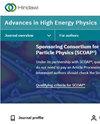求助PDF
{"title":"用QCD求和规则寻找魅力重子和二重子结构","authors":"Xiu-Wu Wang, Zhi-Gang wang","doi":"10.1155/2022/6224597","DOIUrl":null,"url":null,"abstract":"<jats:p>In the present work, we construct eight six-quark currents to study the <jats:inline-formula>\n <math xmlns=\"http://www.w3.org/1998/Math/MathML\" id=\"M1\">\n <msub>\n <mrow>\n <mi>Σ</mi>\n </mrow>\n <mrow>\n <mi>c</mi>\n </mrow>\n </msub>\n <msub>\n <mrow>\n <mover accent=\"true\">\n <mi>Σ</mi>\n <mo stretchy=\"true\">¯</mo>\n </mover>\n </mrow>\n <mrow>\n <mi>c</mi>\n </mrow>\n </msub>\n </math>\n </jats:inline-formula> baryonium and <jats:inline-formula>\n <math xmlns=\"http://www.w3.org/1998/Math/MathML\" id=\"M2\">\n <msub>\n <mrow>\n <mi>Σ</mi>\n </mrow>\n <mrow>\n <mi>c</mi>\n </mrow>\n </msub>\n <msub>\n <mrow>\n <mi>Σ</mi>\n </mrow>\n <mrow>\n <mi>c</mi>\n </mrow>\n </msub>\n </math>\n </jats:inline-formula> dibaryon states via the QCD sum rules. For either <jats:inline-formula>\n <math xmlns=\"http://www.w3.org/1998/Math/MathML\" id=\"M3\">\n <msub>\n <mrow>\n <mi>Σ</mi>\n </mrow>\n <mrow>\n <mi>c</mi>\n </mrow>\n </msub>\n <msub>\n <mrow>\n <mover accent=\"true\">\n <mi>Σ</mi>\n <mo stretchy=\"true\">¯</mo>\n </mover>\n </mrow>\n <mrow>\n <mi>c</mi>\n </mrow>\n </msub>\n </math>\n </jats:inline-formula> baryonium or <jats:inline-formula>\n <math xmlns=\"http://www.w3.org/1998/Math/MathML\" id=\"M4\">\n <msub>\n <mrow>\n <mi>Σ</mi>\n </mrow>\n <mrow>\n <mi>c</mi>\n </mrow>\n </msub>\n <msub>\n <mrow>\n <mi>Σ</mi>\n </mrow>\n <mrow>\n <mi>c</mi>\n </mrow>\n </msub>\n </math>\n </jats:inline-formula> dibaryon states, we construct four currents with the <jats:inline-formula>\n <math xmlns=\"http://www.w3.org/1998/Math/MathML\" id=\"M5\">\n <msup>\n <mrow>\n <mi>J</mi>\n </mrow>\n <mrow>\n <mi>P</mi>\n </mrow>\n </msup>\n <mo>=</mo>\n <msup>\n <mrow>\n <mn>1</mn>\n </mrow>\n <mrow>\n <mo>−</mo>\n </mrow>\n </msup>\n <mo>,</mo>\n <msup>\n <mrow>\n <mn>1</mn>\n </mrow>\n <mrow>\n <mo>+</mo>\n </mrow>\n </msup>\n <mo>,</mo>\n <msup>\n <mrow>\n <mn>0</mn>\n </mrow>\n <mrow>\n <mo>+</mo>\n </mrow>\n </msup>\n </math>\n </jats:inline-formula> and <jats:inline-formula>\n <math xmlns=\"http://www.w3.org/1998/Math/MathML\" id=\"M6\">\n <msup>\n <mrow>\n <mn>0</mn>\n </mrow>\n <mrow>\n <mo>−</mo>\n </mrow>\n </msup>\n </math>\n </jats:inline-formula>. Except the current <jats:inline-formula>\n <math xmlns=\"http://www.w3.org/1998/Math/MathML\" id=\"M7\">\n <msup>\n <mrow>\n <mn>1</mn>\n </mrow>\n <mrow>\n <mo>+</mo>\n </mrow>\n </msup>\n </math>\n </jats:inline-formula> of <jats:inline-formula>\n <math xmlns=\"http://www.w3.org/1998/Math/MathML\" id=\"M8\">\n <msub>\n <mrow>\n <mi>Σ</mi>\n </mrow>\n <mrow>\n <mi>c</mi>\n </mrow>\n </msub>\n <msub>\n <mrow>\n <mi>Σ</mi>\n </mrow>\n <mrow>\n <mi>c</mi>\n </mrow>\n </msub>\n </math>\n </jats:inline-formula>, we find the Borel windows for the other seven. There are two possible <jats:inline-formula>\n <math xmlns=\"http://www.w3.org/1998/Math/MathML\" id=\"M9\">\n <msub>\n <mrow>\n <mi>Σ</mi>\n </mrow>\n <mrow>\n <mi>c</mi>\n </mrow>\n </msub>\n <msub>\n <mrow>\n <mover accent=\"true\">\n <mi>Σ</mi>\n <mo stretchy=\"true\">¯</mo>\n </mover>\n </mrow>\n <mrow>\n <mi>c</mi>\n </mrow>\n </msub>\n </math>\n </jats:inline-formula> molecular states or compact six-quark states with the <jats:inline-formula>\n <math xmlns=\"http://www.w3.org/1998/Math/MathML\" id=\"M10\">\n <msup>\n <mrow>\n <mi>J</mi>\n </mrow>\n <mrow>\n <mi>P</mi>\n </mrow>\n </msup>\n <mo>=</mo>\n <msup>\n <mrow>\n <mn>1</mn>\n </mrow>\n <mrow>\n <mo>−</mo>\n </mrow>\n </msup>\n </math>\n </jats:inline-formula> and <jats:inline-formula>\n <math xmlns=\"http://www.w3.org/1998/Math/MathML\" id=\"M11\">\n <msup>\n <mrow>\n <mn>0</mn>\n </mrow>\n <mrow>\n <mo>−</mo>\n </mrow>\n </msup>\n </math>\n </jats:inline-formula>. The results of the current <jats:inline-formula>\n <math xmlns=\"http://www.w3.org/1998/Math/MathML\" id=\"M12\">\n <msup>\n <mrow>\n <mn>0</mn>\n </mrow>\n <mrow>\n <mo>+</mo>\n </mrow>\n </msup>\n </math>\n </jats:inline-formula> of <jats:inline-formula>\n <math xmlns=\"http://www.w3.org/1998/Math/MathML\" id=\"M13\">\n <msub>\n <mrow>\n <mi>Σ</mi>\n </mrow>\n <mrow>\n <mi>c</mi>\n </mrow>\n </msub>\n <msub>\n <mrow>\n <mi>Σ</mi>\n </mrow>\n <mrow>\n <mi>c</mi>\n </mrow>\n </msub>\n </math>\n </jat","PeriodicalId":7498,"journal":{"name":"Advances in High Energy Physics","volume":" ","pages":""},"PeriodicalIF":1.5000,"publicationDate":"2021-10-27","publicationTypes":"Journal Article","fieldsOfStudy":null,"isOpenAccess":false,"openAccessPdf":"","citationCount":"2","resultStr":"{\"title\":\"Search for the Charmed Baryonium and Dibaryon Structures via the QCD Sum Rules\",\"authors\":\"Xiu-Wu Wang, Zhi-Gang wang\",\"doi\":\"10.1155/2022/6224597\",\"DOIUrl\":null,\"url\":null,\"abstract\":\"<jats:p>In the present work, we construct eight six-quark currents to study the <jats:inline-formula>\\n <math xmlns=\\\"http://www.w3.org/1998/Math/MathML\\\" id=\\\"M1\\\">\\n <msub>\\n <mrow>\\n <mi>Σ</mi>\\n </mrow>\\n <mrow>\\n <mi>c</mi>\\n </mrow>\\n </msub>\\n <msub>\\n <mrow>\\n <mover accent=\\\"true\\\">\\n <mi>Σ</mi>\\n <mo stretchy=\\\"true\\\">¯</mo>\\n </mover>\\n </mrow>\\n <mrow>\\n <mi>c</mi>\\n </mrow>\\n </msub>\\n </math>\\n </jats:inline-formula> baryonium and <jats:inline-formula>\\n <math xmlns=\\\"http://www.w3.org/1998/Math/MathML\\\" id=\\\"M2\\\">\\n <msub>\\n <mrow>\\n <mi>Σ</mi>\\n </mrow>\\n <mrow>\\n <mi>c</mi>\\n </mrow>\\n </msub>\\n <msub>\\n <mrow>\\n <mi>Σ</mi>\\n </mrow>\\n <mrow>\\n <mi>c</mi>\\n </mrow>\\n </msub>\\n </math>\\n </jats:inline-formula> dibaryon states via the QCD sum rules. For either <jats:inline-formula>\\n <math xmlns=\\\"http://www.w3.org/1998/Math/MathML\\\" id=\\\"M3\\\">\\n <msub>\\n <mrow>\\n <mi>Σ</mi>\\n </mrow>\\n <mrow>\\n <mi>c</mi>\\n </mrow>\\n </msub>\\n <msub>\\n <mrow>\\n <mover accent=\\\"true\\\">\\n <mi>Σ</mi>\\n <mo stretchy=\\\"true\\\">¯</mo>\\n </mover>\\n </mrow>\\n <mrow>\\n <mi>c</mi>\\n </mrow>\\n </msub>\\n </math>\\n </jats:inline-formula> baryonium or <jats:inline-formula>\\n <math xmlns=\\\"http://www.w3.org/1998/Math/MathML\\\" id=\\\"M4\\\">\\n <msub>\\n <mrow>\\n <mi>Σ</mi>\\n </mrow>\\n <mrow>\\n <mi>c</mi>\\n </mrow>\\n </msub>\\n <msub>\\n <mrow>\\n <mi>Σ</mi>\\n </mrow>\\n <mrow>\\n <mi>c</mi>\\n </mrow>\\n </msub>\\n </math>\\n </jats:inline-formula> dibaryon states, we construct four currents with the <jats:inline-formula>\\n <math xmlns=\\\"http://www.w3.org/1998/Math/MathML\\\" id=\\\"M5\\\">\\n <msup>\\n <mrow>\\n <mi>J</mi>\\n </mrow>\\n <mrow>\\n <mi>P</mi>\\n </mrow>\\n </msup>\\n <mo>=</mo>\\n <msup>\\n <mrow>\\n <mn>1</mn>\\n </mrow>\\n <mrow>\\n <mo>−</mo>\\n </mrow>\\n </msup>\\n <mo>,</mo>\\n <msup>\\n <mrow>\\n <mn>1</mn>\\n </mrow>\\n <mrow>\\n <mo>+</mo>\\n </mrow>\\n </msup>\\n <mo>,</mo>\\n <msup>\\n <mrow>\\n <mn>0</mn>\\n </mrow>\\n <mrow>\\n <mo>+</mo>\\n </mrow>\\n </msup>\\n </math>\\n </jats:inline-formula> and <jats:inline-formula>\\n <math xmlns=\\\"http://www.w3.org/1998/Math/MathML\\\" id=\\\"M6\\\">\\n <msup>\\n <mrow>\\n <mn>0</mn>\\n </mrow>\\n <mrow>\\n <mo>−</mo>\\n </mrow>\\n </msup>\\n </math>\\n </jats:inline-formula>. Except the current <jats:inline-formula>\\n <math xmlns=\\\"http://www.w3.org/1998/Math/MathML\\\" id=\\\"M7\\\">\\n <msup>\\n <mrow>\\n <mn>1</mn>\\n </mrow>\\n <mrow>\\n <mo>+</mo>\\n </mrow>\\n </msup>\\n </math>\\n </jats:inline-formula> of <jats:inline-formula>\\n <math xmlns=\\\"http://www.w3.org/1998/Math/MathML\\\" id=\\\"M8\\\">\\n <msub>\\n <mrow>\\n <mi>Σ</mi>\\n </mrow>\\n <mrow>\\n <mi>c</mi>\\n </mrow>\\n </msub>\\n <msub>\\n <mrow>\\n <mi>Σ</mi>\\n </mrow>\\n <mrow>\\n <mi>c</mi>\\n </mrow>\\n </msub>\\n </math>\\n </jats:inline-formula>, we find the Borel windows for the other seven. There are two possible <jats:inline-formula>\\n <math xmlns=\\\"http://www.w3.org/1998/Math/MathML\\\" id=\\\"M9\\\">\\n <msub>\\n <mrow>\\n <mi>Σ</mi>\\n </mrow>\\n <mrow>\\n <mi>c</mi>\\n </mrow>\\n </msub>\\n <msub>\\n <mrow>\\n <mover accent=\\\"true\\\">\\n <mi>Σ</mi>\\n <mo stretchy=\\\"true\\\">¯</mo>\\n </mover>\\n </mrow>\\n <mrow>\\n <mi>c</mi>\\n </mrow>\\n </msub>\\n </math>\\n </jats:inline-formula> molecular states or compact six-quark states with the <jats:inline-formula>\\n <math xmlns=\\\"http://www.w3.org/1998/Math/MathML\\\" id=\\\"M10\\\">\\n <msup>\\n <mrow>\\n <mi>J</mi>\\n </mrow>\\n <mrow>\\n <mi>P</mi>\\n </mrow>\\n </msup>\\n <mo>=</mo>\\n <msup>\\n <mrow>\\n <mn>1</mn>\\n </mrow>\\n <mrow>\\n <mo>−</mo>\\n </mrow>\\n </msup>\\n </math>\\n </jats:inline-formula> and <jats:inline-formula>\\n <math xmlns=\\\"http://www.w3.org/1998/Math/MathML\\\" id=\\\"M11\\\">\\n <msup>\\n <mrow>\\n <mn>0</mn>\\n </mrow>\\n <mrow>\\n <mo>−</mo>\\n </mrow>\\n </msup>\\n </math>\\n </jats:inline-formula>. The results of the current <jats:inline-formula>\\n <math xmlns=\\\"http://www.w3.org/1998/Math/MathML\\\" id=\\\"M12\\\">\\n <msup>\\n <mrow>\\n <mn>0</mn>\\n </mrow>\\n <mrow>\\n <mo>+</mo>\\n </mrow>\\n </msup>\\n </math>\\n </jats:inline-formula> of <jats:inline-formula>\\n <math xmlns=\\\"http://www.w3.org/1998/Math/MathML\\\" id=\\\"M13\\\">\\n <msub>\\n <mrow>\\n <mi>Σ</mi>\\n </mrow>\\n <mrow>\\n <mi>c</mi>\\n </mrow>\\n </msub>\\n <msub>\\n <mrow>\\n <mi>Σ</mi>\\n </mrow>\\n <mrow>\\n <mi>c</mi>\\n </mrow>\\n </msub>\\n </math>\\n </jat\",\"PeriodicalId\":7498,\"journal\":{\"name\":\"Advances in High Energy Physics\",\"volume\":\" \",\"pages\":\"\"},\"PeriodicalIF\":1.5000,\"publicationDate\":\"2021-10-27\",\"publicationTypes\":\"Journal Article\",\"fieldsOfStudy\":null,\"isOpenAccess\":false,\"openAccessPdf\":\"\",\"citationCount\":\"2\",\"resultStr\":null,\"platform\":\"Semanticscholar\",\"paperid\":null,\"PeriodicalName\":\"Advances in High Energy Physics\",\"FirstCategoryId\":\"101\",\"ListUrlMain\":\"https://doi.org/10.1155/2022/6224597\",\"RegionNum\":4,\"RegionCategory\":\"物理与天体物理\",\"ArticlePicture\":[],\"TitleCN\":null,\"AbstractTextCN\":null,\"PMCID\":null,\"EPubDate\":\"\",\"PubModel\":\"\",\"JCR\":\"Q3\",\"JCRName\":\"PHYSICS, PARTICLES & FIELDS\",\"Score\":null,\"Total\":0}","platform":"Semanticscholar","paperid":null,"PeriodicalName":"Advances in High Energy Physics","FirstCategoryId":"101","ListUrlMain":"https://doi.org/10.1155/2022/6224597","RegionNum":4,"RegionCategory":"物理与天体物理","ArticlePicture":[],"TitleCN":null,"AbstractTextCN":null,"PMCID":null,"EPubDate":"","PubModel":"","JCR":"Q3","JCRName":"PHYSICS, PARTICLES & FIELDS","Score":null,"Total":0}
引用次数: 2
引用
批量引用


